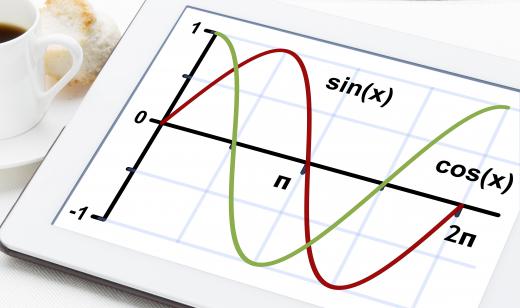A tangent line is a geometric relationship between a line and a curve such that the curve and the line share only one point in common. The tangent line is always on the outside or convex side of the curve. It is impossible to draw a tangent on the inside of a curve or circle. Tangents determine the slope of a curve at a point. They play a role in geometry, trigonometry, and calculus.
Any circle has an infinite number of tangents. The four tangents of a circle that are 90 degrees apart from each other comprise a square that inscribes the circle. In other words, a circle can be drawn inside an exact square and will touch the square at four points. Knowing this is useful in solving many geometry problems involving areas.

Spheres may also have a tangent line, although it is more common to speak of a tangent plane that shares only one point in common with the sphere. An infinite number of tangent lines could pass through that point of intersection, and all would be contained within the tangent plane. These concepts are used in solving problems concerning volumes. A sphere can be placed within a cube. If the diameter of the cube equals the length of the side of the cube, remembering that all sides are the same in a cube, the sphere will share six points in common with the cube.

In trigonometry, the tangent of an angle of a triangle is defined as the ratio of the length of the opposite side to the length of the adjacent side. The triangle is formed by the rays of two radii from the center of a circle. The first ray forms the base of the triangle, and the second ray extends to intersect with the tangent line of the first. Slope is often defined as rise over run. Thus, the tangent, or slope, of the line connecting the two rays is the same as the trigonometric identity.
When considering a tangent line to a curve, unless the curve is the arc of a circle, an observer must note the point of intersection. This is because the curve is not of constant radius. An example of this might be the flight path of a baseball after being hit by a bat.
The ball will accelerate away from the bat but will then reach its apex and descend due to gravity. The flight path will be the shape of a parabola. The tangent to the curve at any point will yield the velocity of the ball at that time.
This mathematical description of the slope of a curve of inconstant curvature is critical to the study of calculus. Calculus enables one to look at the instantaneous rate of change at a point in time. This is useful in controlling reaction rates of processes, rocket fuel consumption for space craft launches, or exactly where to be to catch a baseball.
